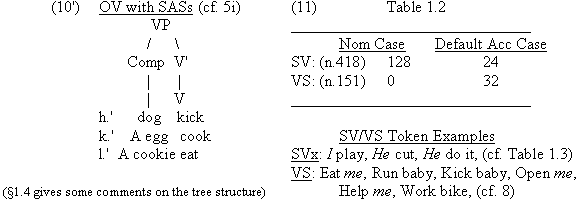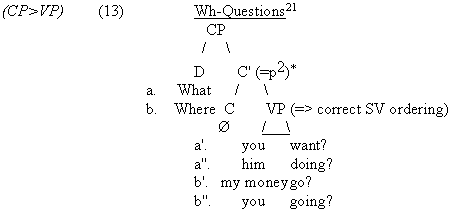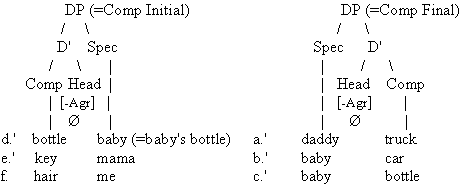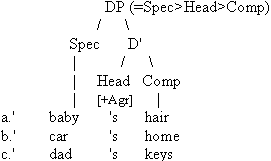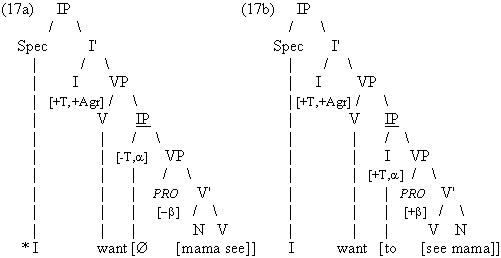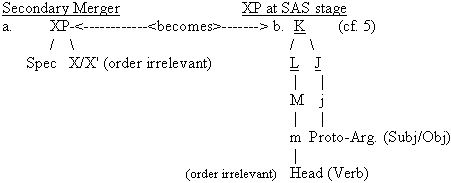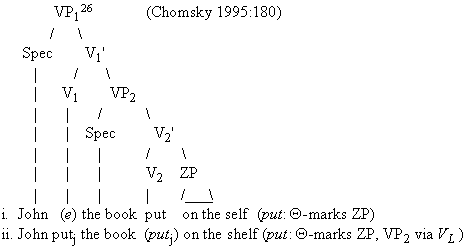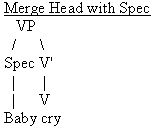
| One interesting observation here concerning such (single argument) VS structures has to do with Case assignment. Most verbs found within VS utterances seem to have Accusative Subjects. This observation becomes rather significant when coupled with other data showing correct Nominative Case usage at the same stages of development (see (9) and (11) below). In other words, the data seem to demonstrate that when VS order is used, Subjects get Accusative Case and never Nominative Case. (NB. The notion that such orders are the result of Dislocations has been largely discredited by negation initial construction: e.g., Neg-V-S/Neg-O-V (see §1.3.1)). In fact, not one VS construction yielded a Nominative Subject. (The fact that Nominative case appears at roughly the same stage may indicate some sort of optional Nominative/Infl stage). However, regarding Case assignment to DP, there does seem to be strong evidence that Genitive Case is unaffected by variable word order. In fact, the Determiner system emerges fairly early on in the data and is found in a variety of environments (not to mention within Language Mixing). The following examples in (9) show correct Case assignment and Word Order patterns for the same developmental periods as was shown in examples (7) and (8) above (ex. a, b are arguably formulaic): (9)
(Objects) Examples of OV/VO structures are also found throughout the range of the data. (Again, recalling our discussion above that word order errors seem to manifest up until the very last file--dependent only on the SAS vs. DAS distinction. Token examples are presented here in (10): (10)
I think what is crucial to note here is that no overt (INFL)ectional verbal morphology (excluding the copula Is (e.g., / Iz_ka: /> Is a car) found in file 5) has yet to surface: viz., all of the VO/OV data suggest that the verb is unspecified for Person. Nominative Case however, also an indicator of INFL, does seem to be established in early SV(X) structures, but an asymmetry is found between the use of Nominative Case in SV and VS structures. The analysis of OVs and token counts (cf. 10) are given below in (10' & 11):
(WH-Questions) Another interesting observation is found concerning Wh-Questions. As alluded to earlier with respect to Kayne, no instances of target word order violations were found among early Wh-initial (+/-Agr/-Tns) constructions. Such results might also be used as argumentation in favor of Kayne's linearization analysis. The arguments might proceed as follows: (12)
(One possible analysis for the following Wh-constructions is to suggest that they are Truncated CP>VP structures as proposed by Radford 1990, 1994, and Roeper and Rohrbacher 1994.)
An important implication here is that no variable ordering is allowed within the VP of a CP>VP structure for reasons discussed in (12)--the Data bear this out. [22] Moreover, a crucial link becomes available now between the Functional stage (made apparent via O-movement) and stable word order (within the VP). However noting that INFL (Agr/Tns) errors still could appear within such structures--as is evident from (13a'')--since IP is altogether missing from the structure (as indicated by the absence of Nom case: him doing?). (Early DP-Projections) A further observation has to do with the fact that word order errors seem also to correspond with the absence of the specification associated with the Head of DP: (possessive 'S). It is observed in the data that the first attempts to project a Possessive construction (DP) (within a non-head DAS) fail to realize the target order. Consider the following examples in (14), where the Head Possessive 'S is unspecified: (14)
The variable word orders cited in (14) could be schematized in the following ways: (14')
In (14) above, Genitive Case assignment is assumed to involve a Spec-Head [+Agr(eement)] relation within DP (Radford: ms1997). The universal potential orderings of Spec-Comp/Comp-Spec however still manifest depending on which of the two universal XP schemata is being utilized.) Again, the crucial claim here relates to the above observation that variable word orders seem to appear within SAS or non-Headed DAS projections: it may be that all categories/(phrases) (Noun (NP), Det (DP), and Verb (VP) alike) are effected in the same way by the Comp parameter--in this sense, even though we are dealing with an apparent (Spec/Comp) DAS construct, the crucial point is that there is no overt Head projection in which to trigger the Comp parameter (cf. Kayne; ex. (6)). It is interesting to note that once the Head of DP overtly projects, word order becomes stable (there are no instances of mixed orders found among specified DP structures). Consider the counterpart structures in (15): (15)
(15')
The structure in (15') draws attention to a possible link between the Functional Parameterization Hypothesis (FPH) via INFL, and the advent of stable word order (at the DAS phase). Namely, as briefly mentioned above, there seems to be some correlation between the onset of unstable word order at the SAS phase and the onset of fixed order at the (FPH) DAS phase. Namely, it is the use of English Possessive INFL(ection) 'S which signals that the child has now developed a specifically ENGLISH type of possessive structure (via INFL) (cf. 15), whereas earlier the child had a 'language-neutral' type of possessive structure (via Non-INFL) (cf. 14). What the above data suggest is that it is the acquisition of the (language-specific) Spec-Head Agreement morphology that fixes word order. In other words, a Directionality/Linearisation Principle might say something along the following lines:
(16)
An interesting observation about the distribution of such word
orders is that strict correlations seem to hold between: (i)
Bare Infinitives and variable word orderings, and (ii)
language-specific To-Infinitives and fixed orderings. In
fact, I have no instances of word order errors found within To-Infinitives:
namely, sentences such as e.g., *I want to [mama see (=OV)],
or *I want to [come mama], are not found in the data. Such
apparent overall IP constructions that permit variable word orderings
(within the V-bar) might be accounted for in the following (highly
speculative) manner.
What this binding between (a,b) attempts to illustrate is that the structures of the (lower) VP seem to share some sort of anaphoric binding relation with the Tense property of IP: e.g., (iff a is [+T], then b is [+T] (situated in Spec-VP)) and the correct directionality of V/N within V' is set (cf 17b)). It remains unclear exactly what type of mechanism we are talking about here regarding how the word order eventually becomes fixed. I can only add at this juncture that the spirit behind this proposal coincides with the notion discussed above--namely, that non-language-specific Bare Infinitives represent an earlier 'single system' (of complementation), and that the eventual use of the specific English morpheme TO signals the development of a separate English structure yielding English word order.
(An Additional Grammatical Stage?) In light of the discussion in the sections above, a slight refinement might now be proposed for how Developmental Linguists describe and assess the stages of child language acquisition. Before the emergence of the VP-stage, commonly referred to as the Small Clause stage (cf. Radford 1988b), an SAS-phase may exist permitting a maximum of two words (e.g., Proto-Argument/Predicate) with an unstable word ordering. The term SAS-phase here doesn't necessarily mean that three or more words can't project, but rather, that the majority of utterances found at this phase seem to comprise of predicate+argument strings only. Furthermore, there is no reason why such a defined SAS-phase could not, in fact, exist alongside a DAS-phase--not to mention the possibility that the phase may be skipped by the child altogether. (In the former case, the child immediately enters the DAS-stage.) The crucial difference then with our proposed SAS-phase, as opposed to a VP-stage, would be the added stipulation that all positions are exclusively A-positions which are in turn directly Q-marked by the Verb-Head within V-bar. Such a stipulation renders movement operations invalid (in adherence to the Theta-criterion--which states that a given argument can receive only one theta-role). The full range of XP expressions (viz., the internal argument V' position), though biologically predetermined to come on-line at the VP-stage, are somewhat suspended at the SAS-phase until specific properties of lexical items having to do with principles of X-bar syntax mature.. [23](In this broader sense, we are talking about the Specifier-Complement asymmetric opposition at the (DAS) phase which triggers the Complement Directionality Parameter as mentioned earlier in (§1.2)). The above stated differences between SASs and DASs amounts to leaving open the question whether or not movement operations are allowed at the VP-stage. (Residual Problems under Minimalist Assumptions) In recapping, one thing the two proposed models seem to have in common (cf. (i) Tsimpli, and (ii) a 'weakened' Kayne) is the fact that they both rely on traditional notions of X-bar syntax: notions that have generally been dispensed with within Bare Phrase Structure (Chomsky 1995: Ch.4). The following cited residual problems take into account more recent interpretations of Bare Phrase Structure regarding Word Order. (Merger) Before moving on to the residual problems, let's first briefly examine how the operation Merge itself might be broken down and analyzed into more fundamental components. Recall that the structure in (5) amounted to a Proto-Argument+Predicate construction. In order to derive the reduced tree in (5), aspects of Merge must also be capable of yielding a reduced tree. It is in this light that we conclude Merge to be formed by two rather independent operations: [24] (18)
(ii) Secondary Merger--Merge Spec with Non-Maximal
Projection (X or X')--
The notion behind (5) is presented above in the form of the secondary merger operation--viz., merge Head with Spec. However, the redefinition of Spec in (5) as a Proto-Argument, and not a true Specifier, is crucial to maintaining the reduced tree in (5). In other words, the child begins her linguistic career (SAS phase) by engaging the second merger operation first--as it is the only operation available--whereby the "Spec" becomes reorganized as the Proto-Argument slot into which Subjects and Objects alike may enter:
The above observations regarding Merge can be summarized
in the following manner: (2) Once the child begins to project Double Argument Strings (DAS), as witnessed by her usage of both Spec and Comp positions, the XP schema is seen as being fully-fledged--thus deriving the potential VP-Shell (cf. Larson) where both Specifiers and Complements are highly active (for reasons having to do with movement operations, etc.) VP-shells, in this sense, are naturally derived from DAS constructions. Target Word Order is set via a coupling of (i) Kayne's Head-Medial Principle and (ii) the eventually setting of the Comp Parameter that triggers correct word order via an agreeing Specifier relation with the Head. Once the VP-shell projects, the functional non-thematic stage has commenced, allowing movement operations and A-bar positions to flourish. (VP-Shell)
The Larsonian VP-shell, I believe, contains two
essential ingredients for supporting the proposal at hand. They
are as follows: (20) (Proposal I)) One notable problem for Tsimpli's model has to do with the assumption of a fully-fledged VP structure at the two-word stage. For instance, consider the child's typical Single Argument String utterance in (I) where only a Specifier and Verb projects:
Regarding current notions of Merger, the idea that a 'traditional' V-bar configuration should inherently take the initial role of merging two syntactic objects [a2, b] forming a new combined syntactic object [a1] is, I think, an intuitive assumption (cf. Chomsky 1995:226, 245). (I fully recognize that some traditional arguments for XP are no longer maintained within Bare Phrase Structure; however, Chomsky does continue to recognize the Head-Complement relation as the most "fundamental" and "local" relation.) However, in (I) above, it is the Specifier and Head which would seem to Merge leaving this fundamental sister Complement position of the Head empty. (This would be counterintuitive, suggesting that children (at the SAS phase), in fact, do recognize that the full XP hierarchy projects). Under Kayne's revised model presented in proposal II, the (SAS) utterance "Baby cry" would be derived by the Merging of [a b] forming [a'] (order irrelevant) via the only relation possible (local or otherwise) between a Proto-Argument (Spec) and Predicate (Head): (II)
The reduced structure in (II), I believe, captures both the essence
of what is innately given for the child--i.e., her innate ability
to realize that X-bar syntax must contain an external branch for
the proto-argument--while, at the same time, offering us an account
of how the child strings such SASs together. (Proposal II) The most outstanding problem for Kayne's approach to word order lies in his dependence on category-terminal distinctions. In Chomsky's Bare Phrase Structure, there is no such distinction. Thus a typical counterpart of (3) above would be the following: (III)
The problem in (III) above is that (m, p) break asymmetrical c-command (ACC) since there is no hierarchical maximal projecting terminal node in the Complement position (p). Chomsky however finds a way to save (ACC) by making a somewhat strong stipulation that either all Complement categories must be a Complex category (with both terminal/non-terminal nodes), or that all right branching structures must end in a trace. (I will not go into the complicated details here, suffice it to say here that such strong stipulations would undoubtedly have ramifications for language acquisition) A second and perhaps more fundamental problem regards the final result--as predicted by Epstein (ibid)--that (LCA) would likewise make available OVS as a (UG) base-generated pattern. There is little evidence to suggest that this pattern actually occurs at all cross-linguistically. Joseph Greenberg (1963) notes regarding Universals that OVS occupies roughly (2%) of the world's languages--a major empirical hurdle to get around (see note 11). At best, it would have to be claimed that OVS is a base structure that simply doesn't survive without immediate morphologically driven movement (at PF)--for one reason or another. (Japanese as a potential OVS language might fall into this category: cf., Tonoike 1995). In sum, this chapter on Word Order overall has demonstrated that indeed a Phase does exist in the acquisition of language where variable word orders are permitted: including both SV/VS, VO/OV structures. The availability of such free orderings was seen to be predominately linked to the early two-word VP-stage (described as the SAS phase, although variant ordered SASs partially continued into the otherwise IP-stage). Utilizing a 'weakened' model of Kayne's LCA (which, in its original form, called for a Spec-Head-Comp universal hierarchy), we showed how the Comp Parameter could establish the correct word order. This finding supported Bowerman's claim that it is the emergence of both overt arguments (viz., the Subject's vs. Object's competitive drive to secure a Spec-position) within a syntactic DAS structure that contributes to the correct setting of the Word Order Parameter. The findings in the data were also made consistent with Tsimpli's work that likewise gave evidence of free word order at the early VP stage. However, we differed with Tsimpli in a number of respects--namely, that free word order was not seen to involve Double Arguments Strings (DAS), and that the correct setting of word order was not seen as a sole consequence of Functional Parameterization, but rather as a result of the two-pronged condition placed on (i) the Head Medial Principle, as well as (ii) the Comp Parameter--in this sense, it was the placement of the Complement in opposition to the Specifier (creating an agreeing Spec) which brought about either universal word order setting: SVO or OVS. The notion that clauses start-off with a minimal VP-structure (a reduced XP), and thenceforth expand as required (once newly acquired structures project), is consistent with the overall Structure-Building model assumed here. Chapter 3 Notes [21] C in adult grammars are assumed to be strong--thus motivating movement in its requirement to be filled. In the child grammar, however, C might remain weak. See also chapter 5 for a more detailed discussion of CP. [22] The data however could also be consistent with the view that when you have Wh-movement, full functional CP>IP>VP structures are in place. [23] See Atkinson (1992: 213) for an in-depth discussion of a maturational based language acquisition programme. (See also Borer et Wexler 1987). For recent accounts of the development of Broca's area regarding the maturation of neural connectivity, (see Simonds et Scheibel 1989, Greenfield 1991, Bickerton 1995, and Wakefield et Wilcox 1995). Bickerton (1992) suggests that the X-bar scheme itself reflects certain neural connectors in the brain which are prone to maturation. [24] The notion of a dual merger operation here is taken from Andrew Radford (pc). [25] . Of course, it is feasible to consider, at this SAS phase, that the child starts-off with a flat structure--in which we have X and XP but not X-bar. This would have the flavor of saying that the child starts by projecting one flat structure until such a time when she comes across more data (DASs) which forces her to project a hierarchical structure. E.g., the need to integrate a third constituent somewhere into her scheme would then force her to provide a full XP. My proposal regarding a 'weakened Kayne' account could work within such a framework. This would match Radford's Uniform Bar Expansion Hypothesis. [26] An interesting note here regards the possibility that only a VP-shell (via movement) can break symmetric configurations/word orders that arise within certain small clauses ( where neither constituent dominates the other). Where e.g., [is [sc[the cause of the riot] [the picture on the wall]]] = (i) The cause of the riot t was the picture on the wall; or (ii) The picture on the wall was the cause of the riot t. Only via movement in the VP-shell is the symmetry broken and XP dominance restored (cf. Moro 1997). * Text taken out of J.A. Galasso (1999) ‘The Acquisition of Functional Categories: A Case Study. (Ph.D. Diss. Essex University (Ch 3)). For references, see Galasso (1999/2003) (Essex/IULC Press).
|
